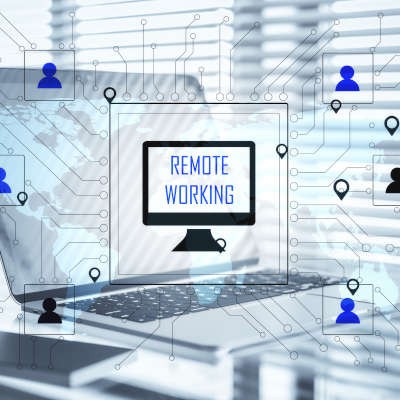The Connection, Inc Blog
Businesses use a vast array of technology for several different purposes. Some businesses use a muted strategy, while others depend on a technology-centered strategy to completely run their business’ operations. With businesses really trying to maximize their profitability, many turn to the automated tools offered by technology to cut their human resources costs. This month we thought we’d discuss some of the basic technology that even the smallest businesses are using to get ahead in a time when it is easy to fall behind.
Whether your business is just starting to open up, or your staff is diligently working remotely, the effects of COVID-19 are going to be long lasting for most businesses. For those of us who were lucky enough to get our employees situated and productive without putting them at risk, we’ve started to see the value in having the infrastructure to allow for remote access.
It’s imperative that you keep your IT infrastructure under control, but many organizations push it to the side. The problem is that ignoring IT often makes it so that you aren’t properly evaluating your technology infrastructure and support, meaning that you could be wasting time and resources that would be better spent elsewhere. Ask yourself the following questions to determine whether or not your IT systems are being maintained properly.
Do You Constantly Suffer from Downtime and Computer Issues?
If you feel like you can’t get anything done due to IT troubles, then you’re throwing money down the drain. Downtime is a major waste, but some of the most recognizable ones include computers that are slow or constantly breaking down, as well as employees who can’t get anything done due to computers that simply don’t work the way they’re supposed to. One of the most devastating downtime incidents--hardware failure--can lead to extended periods of wasteful downtime and large quantities of data loss. It goes without saying that having someone periodically check on IT is a necessity in the modern workplace.
Does It Feel Like Your IT is Being Actively Managed and Maintained...
...or is your current IT provider waiting for you to call them?
Imagine the frustration of getting to your office and having your computer not boot up as intended. Now imagine how much time that costs you if each of your employees encounters this problem. IT can’t always solve issues immediately, but it needs to be able to provide triage and issue support accordingly. If your IT can’t address problems with downtime and connectivity, then perhaps it’s time for a change.
Are Emergencies Treated like Emergencies?
If downtime isn’t treated like the problem that it is, then you’re wasting time and money waiting for issues to be addressed. 10 employees who can’t get their work done due to technology issues means that you’re paying 10 salaries for not completing tasks. This is a waste that your organization can certainly do without. If your IT people aren’t prompt with emergencies, it’s time to find some new IT people.
Can Your Employees Get Support When It’s Needed?
Employees might be worried about asking for support because they are afraid it will cost your business. A ticketing system can be used by employees who run into issues so that they can get the support needed as per your service level agreement. Once the issue has been reported, they can get back to work.
Is Your Network Fully Documented?
Each device on your network, including desktops, laptops, servers, printers, routers, access points, switches, VoIP phones, and everything else, needs to be documented. Documentation should include when the device was purchased and installed, including who installed it, the model and serial numbers, warranty information, and access information.
Is Your Data Being Backed Up?
Without your data, you can’t expect to be successful. If you can’t recover your data in the event of a disaster, your future could be placed in jeopardy. Therefore, your IT people need to take your data as seriously as you do.
Is Your IT Firm Working with You to Discuss and Review Their Own Performance?
IT is about making technology work for you, so if they aren’t doing this, then you should ask them to sit down with you and help determine their worth. It’s even better if they decide to initiate the conversation so they can learn how to best serve you. You need to have an account manager that is willing and able to help you put together a full IT roadmap and plan for the future. If they’re not there to help you get the most from your technology and get ahead of the competition, then what are you paying them for?
The Connection, Inc can be the ideal IT solution for your business. To learn more, reach out to us at (732) 291-5938.
New technology paves the way for businesses to leverage their resources in exciting ways. Of course, it’s impossible to take advantage of these benefits if you don’t even know these new technologies exist. Therefore, to help you achieve an edge over your competition, consider how these four new technologies can enhance your business model.
Smart Virtual Personal Assistants (SVPAs)
Think of SVPAs as virtual executive assistants. These "predictive intelligence" apps use voice recognition to sort through personal data from email messages, address books, calendars, and task lists in order to anticipate the next logical step and drastically boost daily efficiency. Apple, Google, and Yahoo all recently acquired SVPA apps to integrate into predictive products, from mobile apps to smart speakers, helping users get tasks done even before they would remember to do it otherwise.
Security and Privacy Solutions
A perennial on Webbmedia's list, privacy concerns remain top-of-mind for wired Americans. According to a Pew Internet and Society poll, 91 percent agree that consumers have lost control of their personal data. Adobe, Dropbox, and Snapchat have experienced major password breaches, and Target and Home Depot had credit card data from millions of customers stolen by hackers. To address these system breaches and reduce the widespread public mistrust, companies are looking to spend more resources on password security and encryption management. To assist with this, Twitter released Digits, a two-way authentication service that sends one-time confirmation codes via texts, which will be offered to mobile apps.
Internet of Things
Thanks to the Internet of Things, the world we live in is now surrounded by an unprecedented number of devices with the ability to communicate directly with one another, similar to how the Nike FuelBand connects to the coffee maker. These devices will become a vital part of our day-to-day home, work, travel, and shopping experience. The implications on how IoT devices can enhance the productivity and connectivity of businesses as only limited by imagination and the ways that these vast networks can be secured.
Collaborative Software
Looking to make the workday more efficient, a new slew of services combine the best of email, instant messaging, social media, and cloud storage into one platform for collaborating with co-workers. Salesforce's Chatter and Microsoft's Yammer are currently two top players in this space, and with the launch of apps like Facebook for Work, the race to further socialize the office is far from over.
If you can see ways that any of these four technologies can enhance the operations of your business, then The Connection, Inc can walk you through what it takes to implement these solutions. Or, there may be additional new technologies available that you don’t yet know about, simply because you’ve not been introduced to them. To get your business caught up with the latest and greatest technologies, have a conversation with The Connection, Inc today by calling us at (732) 291-5938.
 When running a business, you can’t always upgrade your technology to the latest and greatest equipment or software every time something new comes out. Yet, you also don’t want to be left behind, which would be limiting to your growth and mobility. Moving forward can be a daunting task, especially if you haven’t revamped your IT strategy in some time. Paying attention to the details is an important part of avoiding potential roadblocks with your future IT strategy.
When running a business, you can’t always upgrade your technology to the latest and greatest equipment or software every time something new comes out. Yet, you also don’t want to be left behind, which would be limiting to your growth and mobility. Moving forward can be a daunting task, especially if you haven’t revamped your IT strategy in some time. Paying attention to the details is an important part of avoiding potential roadblocks with your future IT strategy.
 Before investing in a solution for your business, it’s important to understand what you’re getting into. Sometimes it can be difficult, especially with all of the jargon floating around. In fact, an excessive amount of this “geekspeak” can intimidate prospective clients, and maybe even frighten away a sale. While it’s avoided as much as possible, it sometimes can’t be helped, and some business owners are still lost on certain sayings or acronyms.
Before investing in a solution for your business, it’s important to understand what you’re getting into. Sometimes it can be difficult, especially with all of the jargon floating around. In fact, an excessive amount of this “geekspeak” can intimidate prospective clients, and maybe even frighten away a sale. While it’s avoided as much as possible, it sometimes can’t be helped, and some business owners are still lost on certain sayings or acronyms.
 The history of movies is rooted in technological advancement. After all, there are well over 100,000 still photographs in any feature length motion picture. The persistence of vision allows for these images to be strung together by our perception to form the images we see. It didn’t take long after the discovery of this phenomenon for it to be utilized as entertainment, and giving birth to cinema as we’ve come to know it.
The history of movies is rooted in technological advancement. After all, there are well over 100,000 still photographs in any feature length motion picture. The persistence of vision allows for these images to be strung together by our perception to form the images we see. It didn’t take long after the discovery of this phenomenon for it to be utilized as entertainment, and giving birth to cinema as we’ve come to know it.





